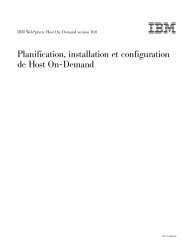Pianificazione, installazione e configurazione di Host On-Demand
Pianificazione, installazione e configurazione di Host On-Demand
Pianificazione, installazione e configurazione di Host On-Demand
You also want an ePaper? Increase the reach of your titles
YUMPU automatically turns print PDFs into web optimized ePapers that Google loves.
Tabella 14. Scenari <strong>di</strong> migrazione (Continua)Sistema operativo Versione precedente <strong>di</strong> <strong>Host</strong><strong>On</strong>-<strong>Demand</strong>Scenario <strong>di</strong> migrazionei5/OS e OS/400 4–8 <strong>Host</strong> <strong>On</strong>-<strong>Demand</strong> <strong>di</strong>sinstallaautomaticamente la versioneprecedente dal sistema esostituisce ad essa <strong>Host</strong><strong>On</strong>-<strong>Demand</strong> 10, lasciandointatti i file personalizzati.Consultare “Installazione sui5/OS e OS/400” a pagina66.Qualsiasi altro sistemaoperativo senza unprogramma <strong>di</strong> utilità <strong>di</strong><strong>di</strong>s<strong>installazione</strong> nativo, adesempio z/OSnon valido Consultare “Migrazione suisistemi operativi del serversenza un programma <strong>di</strong><strong>di</strong>s<strong>installazione</strong>” a pagina 81.Impostazione <strong>di</strong> una <strong>di</strong>rectory <strong>di</strong> pubblicazione utente separataIn <strong>Host</strong> <strong>On</strong>-<strong>Demand</strong> 7 e successive, è possibile memorizzare i file HTMLpersonalizzati (i file generati dal Wizard per la <strong>configurazione</strong>) e i fileconfig.properties e CustomizedCAs.class o CustomizedCAs.p12 in una <strong>di</strong>rectory<strong>di</strong>versa dalla <strong>di</strong>rectory <strong>di</strong> pubblicazione <strong>di</strong> <strong>Host</strong> <strong>On</strong>-<strong>Demand</strong>.La creazione <strong>di</strong> una <strong>di</strong>rectory <strong>di</strong> pubblicazione utente separata semplifical’applicazione <strong>di</strong> aggiornamenti <strong>di</strong> <strong>Host</strong> <strong>On</strong>-<strong>Demand</strong> poiché l’<strong>installazione</strong> <strong>di</strong> unanuova versione <strong>di</strong> <strong>Host</strong> <strong>On</strong>-<strong>Demand</strong> non influenzerà la nuova <strong>di</strong>rectory. Conservainoltre la <strong>di</strong>rectory <strong>di</strong> pubblicazione <strong>di</strong> <strong>Host</strong> <strong>On</strong>-<strong>Demand</strong> in uno stato <strong>di</strong> solalettura perché fornisce un’ubicazione scrivibile separata per la <strong>di</strong>stribuzione <strong>di</strong>pagine del Wizard per la <strong>configurazione</strong>. La creazione, inoltre, <strong>di</strong> una <strong>di</strong>rectory <strong>di</strong>pubblicazione utente separata isola i file generati dal cliente da quelli forniti da<strong>Host</strong> <strong>On</strong>-<strong>Demand</strong>. Notare che gli altri file mo<strong>di</strong>ficati dall’utente (come ad esempiole applet cliente e i programmi HACL) continuano a dovere essere eseguiti dalla<strong>di</strong>rectory <strong>di</strong> pubblicazione <strong>di</strong> <strong>Host</strong> <strong>On</strong>-<strong>Demand</strong>.1. Per impostare una <strong>di</strong>rectory <strong>di</strong> pubblicazione utente separata, procedere nelseguente modo:v Per il client <strong>di</strong> download o per il client con memorizzazione nella cache,specificare la base co<strong>di</strong>ce. La base co<strong>di</strong>ce è la <strong>di</strong>rectory <strong>di</strong> pubblicazione delserver <strong>Host</strong> <strong>On</strong>-<strong>Demand</strong>, non il nome della nuova <strong>di</strong>rectory <strong>di</strong>pubblicazione utente separata:a. Utilizzando il Wizard per la <strong>configurazione</strong>, nella finestra Opzioniaggiuntive, fare clic su Opzioni avanzate.b. Aprire la finestra Base co<strong>di</strong>ce.c. Immettere la base co<strong>di</strong>ce. E’ possibile specificare un URL completo, cheinclude il nome host (ad esempio http://server_HOD/alias_<strong>di</strong>r_pubblicazione_hod/) oppure un percorso relativo (ad esempio,/alias_<strong>di</strong>r_pubblicazione_hod/).Continuare con il passo 2 a pagina 80.v Per un client <strong>di</strong> Avvio Web, specificare la base documento. Il client <strong>di</strong> AvvioWeb è un’applicazione e pertanto non ha un metodo integrato perdeterminare dove viene caricato il file HTML. La base documento consenteCapitolo 8. Aggiornamento da versioni precedenti <strong>di</strong> <strong>Host</strong> <strong>On</strong>-<strong>Demand</strong> 79






